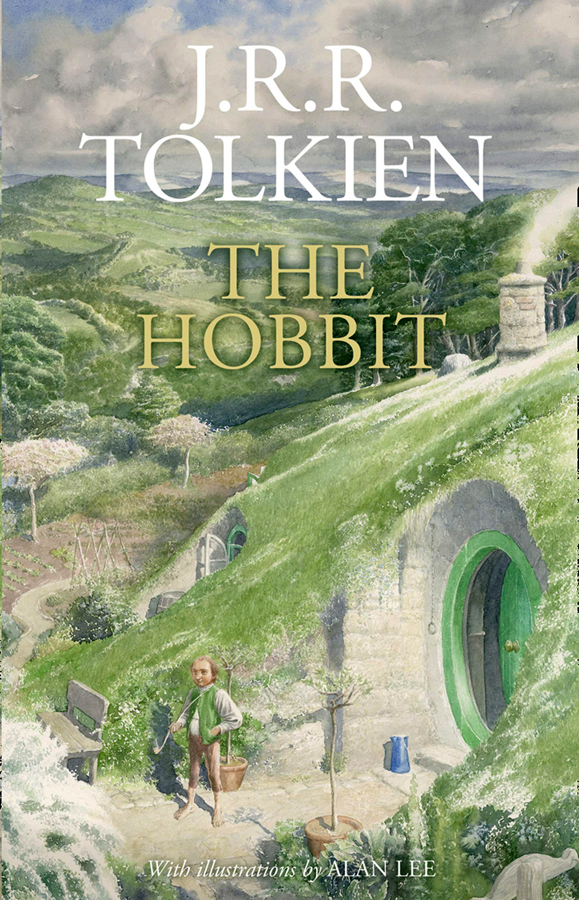“The Hobbit,” or “There and Back Again,” written by J.R.R. Tolkien and first published in 1937, is a timeless work in the fantasy genre, offering a richly imagined world filled with memorable characters, profound themes, and a narrative that balances epic adventure with a sense of homely charm. This review aims to comprehensively analyze the novel, touching upon its plot, characters, themes, literary style, and its place in the broader context of fantasy literature and Tolkien’s legendarium.
Introduction
The narrative of “The Hobbit” centers on the journey of Bilbo Baggins, a hobbit who enjoys a comfortable and unambitious life in the Shire. His world is turned upside down when the wizard Gandalf and a company of dwarves led by Thorin Oakenshield enlist him as a burglar on a quest to reclaim the Lonely Mountain and its treasure from the dragon Smaug. The story unfolds as a classic quest narrative, with Bilbo and the dwarves encountering various challenges and adversaries, including trolls, goblins, giant spiders, and elves, as well as the enigmatic creature Gollum, from whom Bilbo acquires the One Ring, a central element in Tolkien’s subsequent “The Lord of the Rings.”
Style and Narrative
Bilbo Baggins is the heart of the novel, undergoing significant character development. From a cautious and comfort-loving hobbit, he develops into a brave and resourceful hero, a believable and compelling transformation. The character of Thorin Oakenshield is also notable for his complexity; his noble quest is marred by his growing greed and obsession with the reclaimed treasure. The supporting characters, including the other dwarves, Gandalf and Gollum, are vividly drawn, each contributing to the story’s depth and Bilbo’s development.
Tolkien weaves several themes into the narrative. The journey motif represents personal growth and self-discovery. The contrast between home and the outside world highlights the tension between comfort and adventure. Themes of greed and the corrupting influence of wealth are embodied in the characters of Thorin and Smaug. Additionally, the novel touches upon themes of friendship, bravery, and the importance of wit, resourcefulness, and providence.
Tolkien’s narrative style in “The Hobbit” is notable for its blend of mythology, adventure, and humor. The language is accessible yet rich, filled with poetic descriptions and a sense of wonder. The narrative voice is distinct, often directly breaking through to the reader, adding to the story’s charm. “The Hobbit” is a seminal work of fantasy and a masterful piece of storytelling that appeals to both young and adult readers. Its enduring appeal lies in its richly imagined world, the depth of its characters, the universality of its themes, and its balance of humor, adventure, and moral seriousness. As both a self-contained story and an integral part of Tolkien’s larger legendarium, it holds a significant place in the canon of English literature.
“The Hobbit” is often seen as a precursor to high fantasy, setting the stage for “The Lord of the Rings” and influencing countless other works in the genre. It draws on Tolkien’s extensive knowledge of mythology and languages, particularly Norse myths, which is evident in its world-building and use of runes and ancient languages. As a work written in the inter-war period, it also reflects, albeit subtly, the anxieties and experiences of a world recovering from the Great War.
Theology and Symbolism
Good vs. Evil
The struggle between good and evil is central to “The Hobbit.” This dichotomy is embodied in characters like the noble Bilbo Baggins and Gandalf versus the malevolent Gollum and Smaug. Tolkien’s representation of evil often reflects a Christian understanding, where evil is seen as a perversion or corruption of the good rather than an independent force.
Providence and Fate
The concept of a guiding hand or destiny plays a crucial role in “The Hobbit.” Gandalf’s choice of Bilbo for the adventure and the seemingly random events that lead to significant outcomes (such as the finding of the One Ring) can be interpreted as manifestations of divine providence. This aligns with the Christian belief in God’s omnipotence and His mysterious ways of influencing the world.
Temptation and Moral Growth
Bilbo’s journey can be seen as a moral pilgrimage where he encounters various temptations and trials, such as the lure of the Ring and the treasure of the Lonely Mountain. His character and virtue growth, particularly his courage, generosity, and wisdom, reflect a Christian understanding of moral development and sanctification.
Sacrifice and Redemption
Themes of sacrifice are evident, especially in the context of Thorin Oakenshield’s arc. His eventual realization of greed’s hollowness and subsequent redemption echoes Christian notions of repentance and atonement.
Creation and Sub-creation
Tolkien’s portrayal of Middle-earth, in its detailed geography and history, aligns with his belief in sub-creation. As a devout Christian, he saw artistic creation as a reflection of God’s creative act, a concept he elaborates in his essay “On Fairy-Stories.”
Tolkien’s religious beliefs subtly influenced his writing. He viewed his storytelling as an act of creation, honoring God by mirroring His creativity. However, unlike some contemporary Christian literature, Tolkien eschewed overt allegory or preaching, preferring to let his themes emerge naturally from the narrative and characters. Scholars have long debated the extent and nature of the theological themes in Tolkien’s work. Some argue that the Christian allegories are profound and intentional, while others suggest they are incidental, a byproduct of Tolkien’s own worldview and ethical beliefs. However, the consensus is that “The Hobbit,” like much of Tolkien’s work, is deeply imbued with moral and spiritual significance, reflecting his personal faith and philosophical outlook.
In summary, a theological analysis of “The Hobbit” reveals a narrative rich in Christian symbolism and moral themes. The story, while not overtly religious, is underpinned by a worldview that reflects Tolkien’s own devout Catholicism, characterized by a belief in the fundamental struggle between good and evil, the power of providence, and the importance of moral integrity and redemption. These elements contribute to the enduring appeal and depth of “The Hobbit,” making it a work that resonates with readers on both a literary and spiritual level.
Overview
A chapter-by-chapter review of J.R.R. Tolkien’s “The Hobbit” offers an opportunity to delve into the intricacies of each segment of the story, understanding its contribution to the narrative’s development, themes, and character arcs. “The Hobbit” is structured into nineteen chapters, each unfolding a part of Bilbo Baggins’ journey from a simple hobbit to a brave adventurer. Here is a brief overview of each chapter:
Chapter 1: An Unexpected Party
Introduces Bilbo Baggins, a comfortable hobbit whose life is turned upside down when Gandalf the wizard and a group of dwarves led by Thorin Oakenshield arrive at his door. The chapter sets the stage for the adventure and establishes the primary characters and their quest to reclaim the Lonely Mountain.
Chapter 2: Roast Mutton
The company encounters three trolls. Bilbo’s first attempt at burglary goes awry, but Gandalf ingeniously saves the group. This chapter introduces Bilbo to the dangers of the world beyond the Shire and begins his transformation.
Chapter 3: A Short Rest
The group reaches Rivendell, where they receive aid and advice from Elrond. This chapter introduces the elves and hints at the wider world of Middle-earth, showcasing Tolkien’s rich world-building.
Chapter 4: Over Hill and Under Hill
The travelers face challenges crossing the Misty Mountains. Captured by goblins, they experience their journey’s first truly perilous situation, underscoring the dangers of their quest.
Chapter 5: Riddles in the Dark
Bilbo finds himself lost in the goblin tunnels and encounters Gollum. Their game of riddles is pivotal, leading to Bilbo’s acquisition of the One Ring. This chapter is crucial for its introduction of the Ring and its moral and narrative implications.
Chapter 6: Out of the Frying Pan into the Fire
After escaping the goblins, the company is pursued by Wargs and then rescued by eagles. This chapter highlights the recurring theme of providential help in times of need.
Chapter 7: Queer Lodgings
Gandalf leads the company to the house of Beorn, a shape-shifter. This chapter serves as a respite and introduces another of Middle-earth’s unique characters.
Chapter 8: Flies and Spiders
The company enters Mirkwood, facing hardships and the threat of giant spiders. Bilbo’s bravery and resourcefulness are central, as he plays a key role in rescuing the dwarves.
Chapter 9: Barrels Out of Bond
Captured by Wood-elves, the company escapes using a creative plan involving barrels. This chapter continues to showcase Bilbo’s growing courage and ingenuity.
Chapter 10: A Warm Welcome
The company reaches Lake-town, greeted as heroes. This chapter shifts the setting to a human settlement, expanding the scope of Middle-earth’s cultures and politics.
Chapter 11: On the Doorstep
They reach the Lonely Mountain, searching for the secret entrance. This chapter builds tension and anticipation for the confrontation with Smaug.
Chapter 12: Inside Information
Bilbo encounters Smaug. Their interaction is a highlight, showcasing Bilbo’s cleverness and the dragon’s arrogance, setting the stage for the story’s climax.
Chapter 13: Not at Home
The company explores the treasure hoard after Smaug leaves. Themes of greed and its corrupting influence begin to surface, particularly in Thorin.
Chapter 14: Fire and Water
Smaug attacks Lake-town, and Bard the Bowman defeats him. This chapter connects the dragon’s fate to the broader world, showing the impact of the quest on others.
Chapter 15: The Gathering of the Clouds
With Smaug dead, various parties converge on the Lonely Mountain, seeking a share of the treasure. The chapter sets up the conflict over the treasure and Thorin’s increasing obstinacy.
Chapter 16: A Thief in the Night
Bilbo uses the Arkenstone to broker peace, highlighting his growing moral complexity and desire to prevent bloodshed.
Chapter 17: The Clouds Burst
The Battle of Five Armies ensues. This chapter is a climax of action, with significant consequences for all characters involved.
Chapter 18: The Return Journey
Reflective and bittersweet, this chapter deals with the aftermath of the battle, losses, and the journey home, emphasizing the cost of adventure.
Chapter 19: The Last Stage
Bilbo returns to the Shire, finding it mostly unchanged. However, he is profoundly transformed. The chapter concludes the story on a note of melancholy yet contentment, with Bilbo embracing both his adventurous and hobbit sides.
In summary, each chapter of “The Hobbit” contributes to the overarching narrative, developing characters, advancing the plot, and enriching the world of Middle-earth.


















